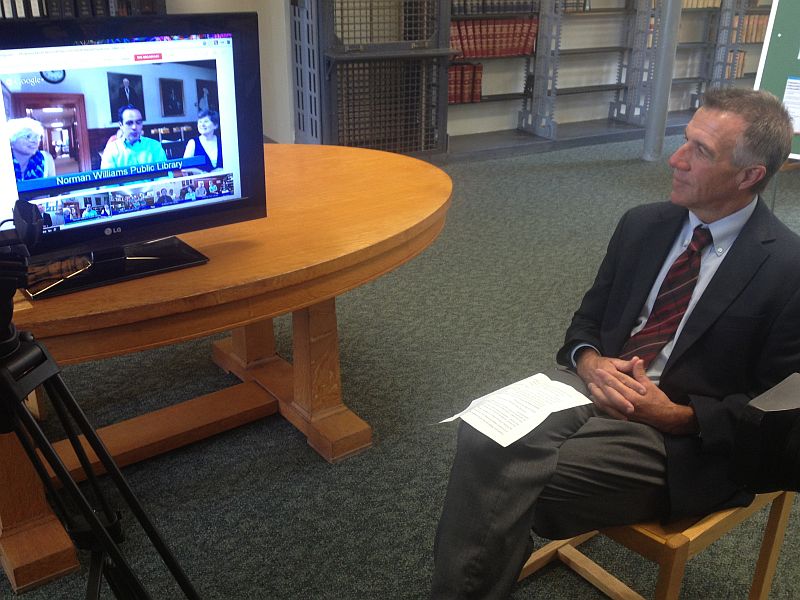With air travel becoming an increasingly unpleasant, unpredictable, and costly experience; rising gas prices; and thousands of hours lost to travel time , it doesn’t take a genius to see that multipoint video conferencing should be pervasive across all areas of industry and government — and yet it’s not.
A recent study by Mobile Work Exchange yielded some promising numbers. If half of all federal government workers used cloud-based video conferencing, concluded the report, they would achieve an average productivity increase of 3.5 hours per week, shave about $4.95 billion from annual travel costs, and, in total, save an estimated $8 billion a year.
With such compelling returns, it’s no wonder that Congressman Mike Fitzpatrick is leading the promotion of a new bill designed to reduce federal government travel spending by 50 percent, H.R. 2643, the Stay In Place, Cut the Waste Act of 2013, by implementing the broad use of Internet video conferencing. What’s surprising is that this hasn’t already happened, and not just in government, but in education, healthcare, and retail.
Recent analyst reports show that the mass adoption of online video conferencing is a phenomenon still waiting to happen. For example, Infonetics Research described 2012 as a ‘rotten’ year for the traditional videoconferencing industry, and IDC’s report for the first quarter of this year was equally glum.
Part of the problem is that the market is confused by a plethora of new offerings with widely differing functions and access methods. A bigger issue is the very deep gap dividing two polarized segments of the industry: high-end, high-cost, high-maintenance, boardroom-level offerings and person-to-person, low-cost, low-function products.
The Underserved 20 Million
Stuck in the middle, there’s a miserable gap where an estimated 20 million rooms —which should be serving small, collaboration teams; cash-strapped SMB organizations; or meetings of six people or fewer — are waiting for an answer to their pent-up demand. Chances are any of these groups that are currently using video have fudged together a multipart solution of counterproductive complexity or are huddling three to a chair behind a webcam and computer screen.
Even organizations with videoconferencing facilities already in place only have them in 5 percent of available meeting rooms — primarily because of the high cost of adding to a traditional system or because more affordable systems did not work with what was already there.
For the channel, these 20 million secondary conference rooms represent a $15 billion to $20 billion market opportunity to provide videoconferencing for the rest of us. There are a growing number of solutions to serve this middle-of-the-pack segment, but momentum is slow to mount. Why? Well, although it’s difficult for the layperson to choose between cloud-based, virtualized, software-centric, browser-based, or hardware-based systems, the biggest problem lies in what people think they know, but actually don’t.
Below are the six top misconceptions preventing more organizations and more individuals from riding the HD video conferencing wave immediately — and the answers that solutions providers can provide to put them on the right track.
1. The equipment is too expensive. Wrong!
Even on a small budget, you can hold out for high-quality, business-class equipment that doesn’t require an IT support genius to make it work. Standards-based, multipoint video conferencing, content sharing, and security is available at less than $1,000 per room via some of the newest, all-in-one systems.
2. It won’t work without an expensive, purpose-built video infrastructure. Wrong!
New product options mean you can use a virtual, cloud-based infrastructure instead of making a heavy investment in servers and other hardware. Some new offerings support desktop video conferencing standards to work both with existing, in-house infrastructures as well as the cloud.
3. You need dedicated IT support to get every video call started. Wrong!
The latest solutions are designed for nontech specialists and are easy to use. Lightest on IT support and budgets are the latest all-in-one, HDTV-based systems. Because they don’t need to be connected to a PC with separate speakers, microphone, and camera, even your Granny can use them. (And, actually, she possibly does: long term care residences are beginning to adopt video calling for virtual family visits.)
4. New room systems must be the same brand as existing boardroom video systems. Wrong!
Newer, standard-based video conferencing software solutions work with most of the traditional videoconferencing vendors’ equipment and connect multiple different systems, fixed and mobile devices to sync up with whatever is already installed in the main conference room.
5. You can’t mix cloud-based and on-premise. Wrong!
Cloud-based and on-premise options are now available on the same appliance-based solutions. These options can be used in the same organization using either the existing system or a cloud-based virtual infrastructure for hybrid architecture flexibility. The flexibility allows for many creative deployment scenarios without cutting users out of the main video network.
6. It makes sense to wait for WebRTC to become commercially available. Wrong!
WebRTC is exciting, but it is still some time away from being a useful standard. For immediate best video conferencing software needs, buy a system from a vendor that’s committed to a universal standard with WebRTC, SIP (session initiation protocol), and emerging standards in their roadmap.
If we can help more potential best video conference software users understand the truth concealed behind these misconceptions, the new class of affordable, room-based videoconference systems become an exciting and immediate way for solutions providers to seize on a massive market opportunity.
Article Source: 6 misconceptions getting in the way of video conferencing growth

.jpg)

